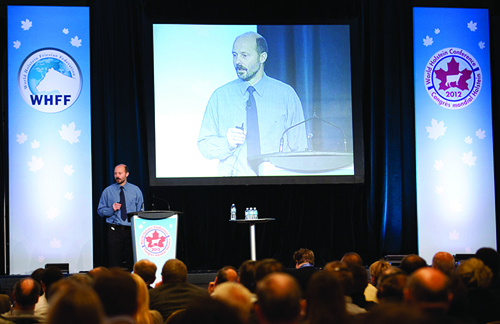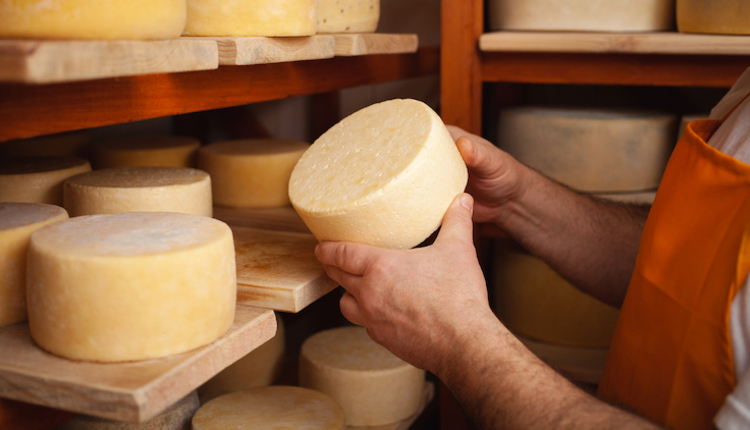
It's an event that happens only once every four years - the global gathering of the World Holstein Friesian Federation. Since this event hosted by Holstein Canada coincided with the four-year anniversary of the release of genomic information on Holsteins, the meeting had a focus like no other past event dating back to 1964. During the conclave, the meeting rooms with the 600-plus attendees were abuzz as they deliberated on the impact the new science is having in their respective countries.
To date, genomics has been a male-dominated discussion as most countries outside North America do not publish genomic evaluations on females. However, throughout the presentations, it was quite evident that breeders worldwide are gearing up to work with genomics on their female populations in 2013. At the moment, international breeders are sending some samples from their elite females to the U.S. or Canada to gain more insight about genetic values.
Costs are falling
"The costs of sequencing an individual's genetic makeup have dropped big time," said Ben Hayes with Australia's Department of Primary Industries. "In 2003, it cost $300 million to read the entire genetic profile on an individual. By 2007, those costs fell to $1 million; $60,000 in 2008; and $5,000 in 2010," said the geneticist, contrasting costs for complete genomic profiles versus those available in the more familiar 6K, 9K or 50K tests available to breeders. "Now we can read an individual's entire genetic code for $2,000."
"As these costs continue to drop, we will be able to learn more about breeding better cattle," Hayes said. "One such project is the 1,000 bulls genome project that we are conducting with global partners."
"If we can genome sequence entire individuals, we could end up with higher reliability on genomic breeding values. We anticipate knowing this additional information will have a smaller impact on production traits but it will have a much larger impact on fertility and other traits that have low heritabilities," explained Hayes.
In other work, Hayes detailed a collaborative project with New Zealand scientists where the two partners are using the combination of genomics and feeding trials to get a better handle on feed efficiency. Each group has tested 1,000 Holstein heifers each.
"Our work indicates there is a 3.3 pound difference in daily intakes for the same growth between the top 10 and the bottom 10 percent of heifers," said Hayes. "We are finding that initial genomic reliability for feed efficiency is around 40 percent for heifers," he said noting full results should be available within two years.
One last project Hayes touched on was using rumen micro-biome profiles to predict phenotypes. "Rumen environments are so unique, there isn't one that is alike in bacteria profiles. They are almost like fingerprints," he said. "Only 4 percent of the DNA in a cow's gut is her own . . . 96 percent is from microbes. Pursuing this research could unlock valuable information to improve feed conversation and reduce methane emissions," said Hayes.
Need to counteract inbreeding
"Inbreeding has been a concern for a long time," said Flavio Schenkel, geneticist at the University of Guelph, Ontario, Canada. "It reduces production, lowers fertility, causes more stillbirths and leads to less days in the herd," he said. "Has genomics changed this situation?"
"No, inbreeding is even a bigger concern. Inbreeding has been going up from 1970 to 2012. However, the trend has been accelerating since 2011. We do need more data to confirm the new trend," said Schenkel.
"While we are making faster genetic progress, there isn't as much time for selection to counterbalance the negative effects of inbreeding," said Schenkel noting the generation interval has been shortened as more young bulls with genomic-only evaluations are selected as sires for the next generation. Likewise, more virgin heifers are flushed as potential bull mothers.
"There is also evidence that genetic diversity, another indicator of inbreeding, is shrinking," said Schenkel. "To counteract these developments, we will need to move from using traditional pedigrees to using genomic relationships to calculate inbreeding. Genomics allow us to know how genetically related that individual is to the greater population," he explained, noting that each offspring doesn't inherit a perfect 50-50 mix of genetics from its sire and dam.
As for diversity
"At the dawn of genomics in 2008, 126 bulls sired the next generation of young bulls," said Marjorie Faust with ABS Global when discussing the U.S. Holstein population. "In 2010, 144 bulls sired the next generation: 82 proven and 62 young bulls with genomic-only evaluations. One year later, 276 bulls were bull fathers with 89 being progeny proven and 187 being DNA-tested," she said. "Does this represent true growth in the number of sire families represented? Will this trend continue?" she asked. "Those are questions that remain unanswered," said the U.S.-based geneticist.
The number of Holsteins with genomic profiles continues to rise in the U.S. as more producers adapt to the technology. "To date, 230,000 Holsteins have genomic information," said Faust. "Of that, 162,000 are females and 68,000 are males."
"Genomic estimates are not only driving elite breeding programs but all breeding programs," said Faust. "All Holstein breeders are buying more genomic bulls when compared to proven bulls. In 2011, 48 percent of all inseminations in the U.S. were to young, genotyped bulls."
Josef Potts from Germany confirmed the trend, "In Germany, 45 percent of services were to genomic young bulls in May 2012. I believe that number is closer to 50 percent now."
Get more from your cows
As the conference ensued, conversations turned towards more traditional topics. The University of Wisconsin-Madison's Ken Nordlund, D.V.M., told attendees, "The length of free stalls does more to reduce longevity in large-framed Holsteins than anything else. The modern free stall should be 9 feet long and 4 feet wide.
"We also must get past conventional wisdom that suggests the most expensive thing on the dairy is an empty stall. This is nonsense!" exclaimed Nordlund. "The most expensive thing on a dairy is a prefresh stall that is always full."
Staying with cow care, Canada's Gerard Cramer, D.V.M., stated, "The quickest thing to improve lying time is to move to deep bedding. It doesn't matter what kind."
Arie Hamoen, chairman of the World Holstein Friesian Federation's type harmonization committee, summarized the international type conference, "Our group has concluded that foot angle, rear legs-rear view, locomotion and angularity are traits that would benefit from more harmonization from country-to-country. We believe our global classification workshop in Niagara Falls went a long way towards accomplishing that goal."
In one of the conference's later presentations, Holstein U.K.'s Lucy Andrews-Noden nicely summarized the many talks on breeding, "It takes a minute to put that straw of semen into a cow, and a lifetime to breed out a problem."
This Hoard's Dairyman editorial appears on page 11 of the January 11, 2013 issue.








